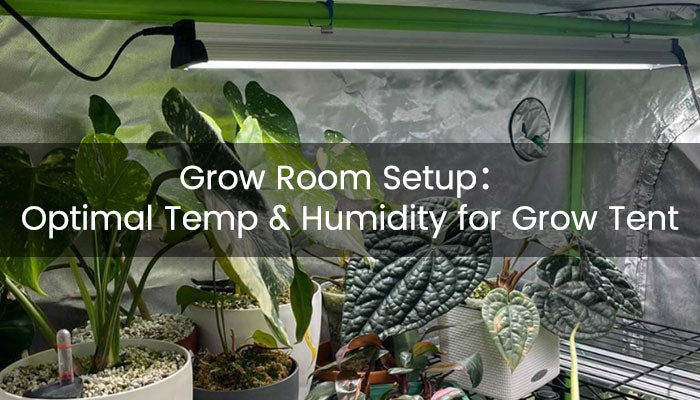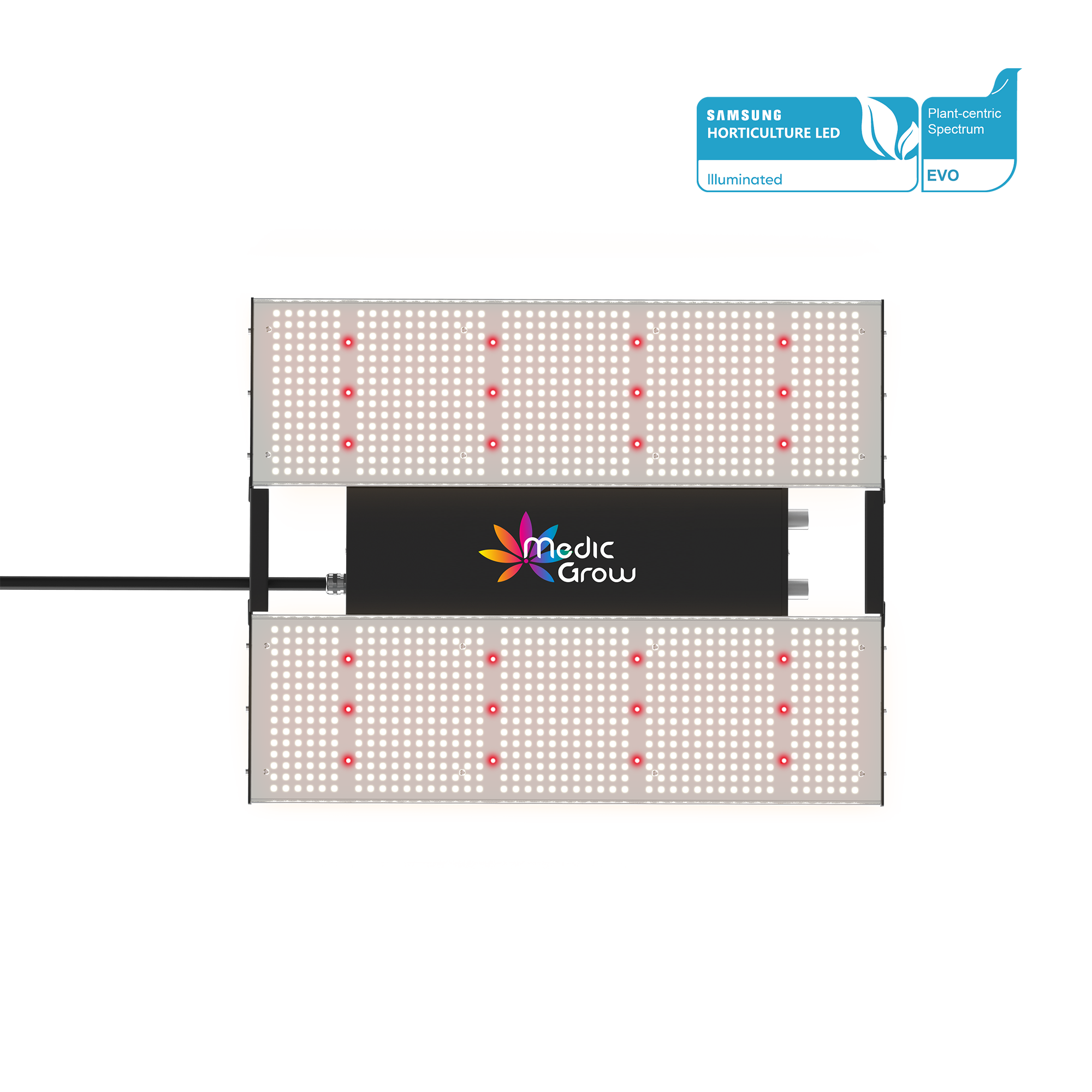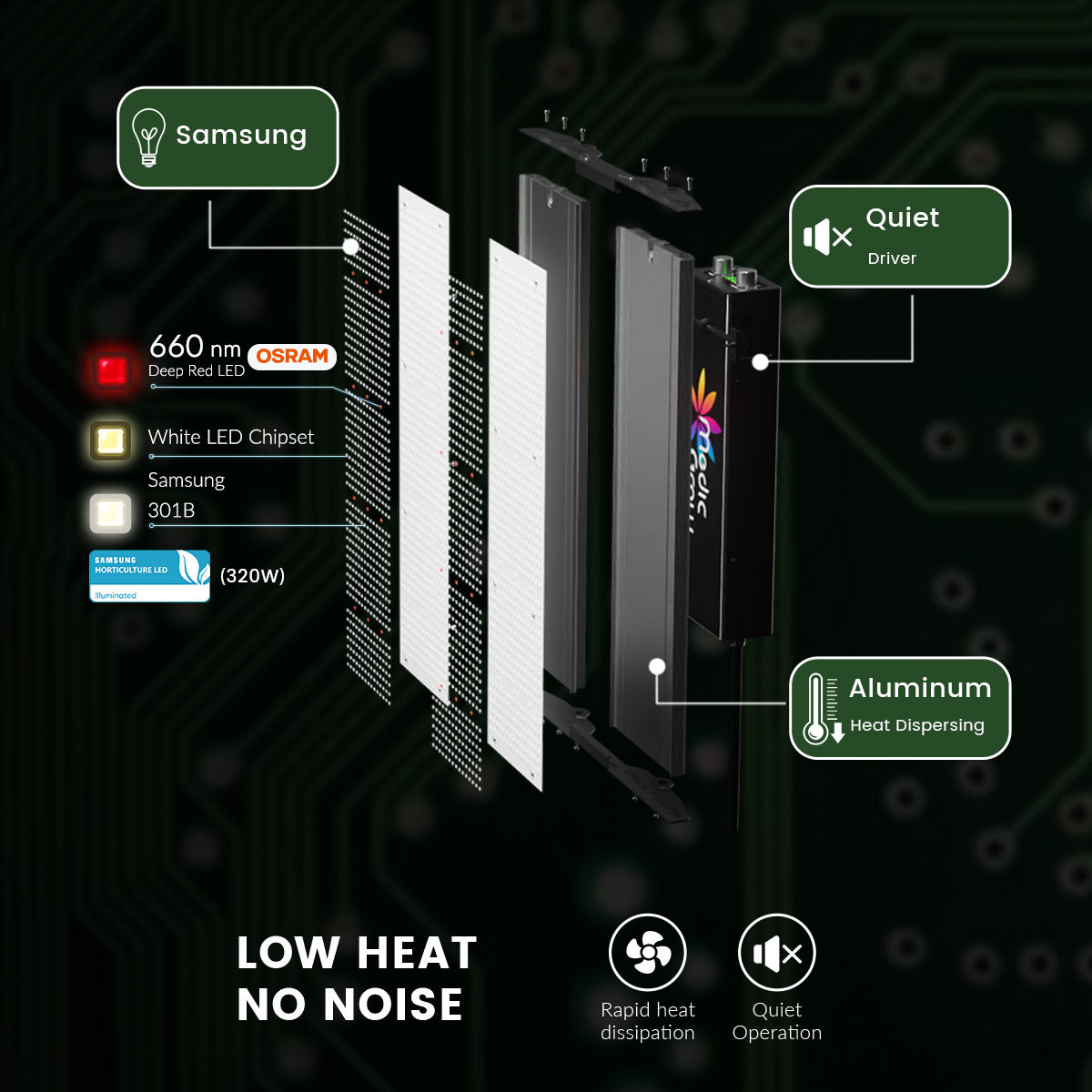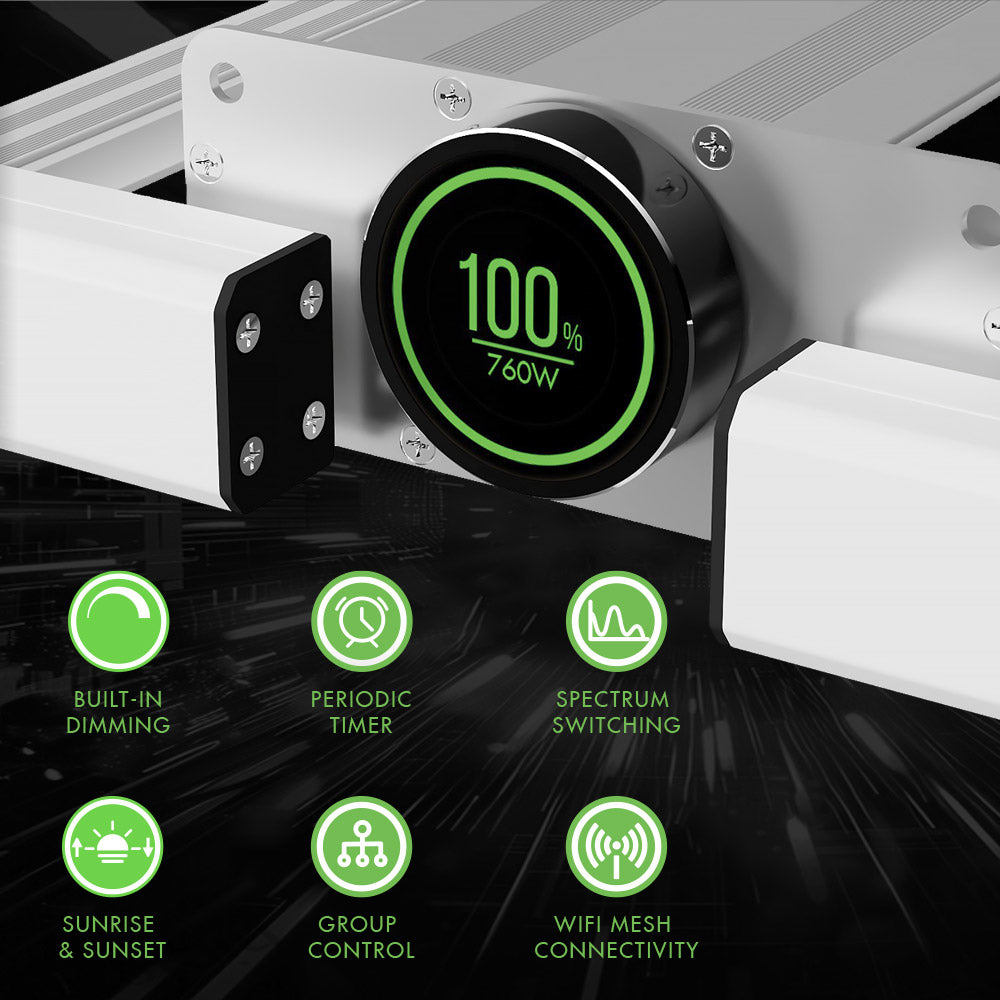
Grow Room Setup: Optimal Temp & Humidity for Grow Tent
As more regions legalize green herbs, both investors and individual growers are flocking to the industry. According to green herb Sales Projections for US Markets in 2025, the green herb market is expected to reach approximately $43 billion by 2025.
This offers both opportunities and challenges for indoor growing, as it can be tough to produce high-quality green herb products consistently. They have strict requirements for plant growth lights, nutrients, and grow tent temperature. But don't worry, MedicGrow is here to help.
We’ll guide the ideal indoor temperature and humidity levels for different green herb growth stages, including ideal seedling humidity and the best humidity for the flower. I hope this can help you create the perfect environment for your plants to thrive.
Main Content:
- 1. Why are Temp and Humidity Important for a green herb
- 2. What Are the Optimal Temperature and Humidity Levels for green herb
- 3. How to Maintain Optimal Humidity Levels and Temperature
- 4. Conclusion
- 5. FAQs about Grow Room Temp and Humidity Chart
Why are Temp and Humidity Important for a green herb
green herb plants rely on optimal temperatures to perform photosynthesis effectively. High temperatures can lead to overheating, slowing down, or halting the outputs of photosynthesis. Conversely, low temperatures slow down the metabolic processes necessary for growth.
According to a study from the University of Mississippi, the rate of photosynthesis in green herbs decreases significantly at temperatures above 30°C (86°F). Prolonged exposure to temperatures over 40°C (104°F) can cause irreversible damage and reduced yields.
Extreme temperature fluctuations may even result in hermaphroditism in green herb plants, allowing them to self-pollinate and produce seeds instead of flowers.
On the other hand, humidity levels are crucial for preventing mold on green herbs, especially during the flowering stage when dense flowers increase relative humidity. High relative humidity can promote the growth of molds such as botrytis (flower rot) and powdery mildew.
Temperature and humidity also affect the plant’s ability to absorb nutrients. If the temperature is too high or the humidity is too low, the plant may struggle to take in essential green herb nutrients, leading to deficiencies and reduced yields.
As noted by Robert Clarke's Green Herb: Evolution and Ethnobotany, maintaining optimal temperature and humidity levels helps sustain an ideal transpiration rate, which promotes nutrient uptake and development in green herbs.
Moreover, terpenes and resin in green herbs are sensitive to temperature and humidity. Lower temperatures in the late flower (around 18-22°C or 64-72°F) help increase terpene distribution and resin content, enhancing potency and flavor.
As you can see, the temperature and humidity in a grow room are crucial for green herbs and they can interact with each other. Maintaining optimal temperature and humidity can result in higher yields with more aromatic, potent, and flavorful flowers.
Best temp and humidity chart for a green herb

What Are the Optimal Temperature and Humidity Levels for Green Herbs?
The best temperature and humidity levels for green herbs vary based on the growth stage. For seedlings, 68-77°F temp and 65-70% humidity. For vegetation, 72-82°F temp and 40-60% humidity. For flowering, 68-79°F temp and 40-50% humidity. The Night temp should be 5-10°F lower than the daytime.
Adjusting the temperature and humidity based on the different growth stages of green herbs can better meet the plant’s needs. Below is a breakdown of the temperature and humidity requirements for each stage, along with a green herb dry temp and humidity chart.
Seedling Stage
- Light On Temperature: 68-77°F (20-25°C)
- Light Off Temperature: 63-72°F (17-22°C)
- Humidity: 65-70% relative humidity (RH)
During seedling, plant needs a stable, warm environment (68-77°F) to support cell division and root growth. A drop in temp during the lights-off mimics natural nighttime, preventing stress and encouraging root development.
For ideal seedling humidity, It's important to maintain high humidity levels of 65-70%. It's because seedlings have underdeveloped root systems and heavily rely on leaf transpiration for water absorption, maintaining high humidity levels helps retain moisture in the leaves.
This recommended temperature and humidity closely mimic the natural conditions in spring when seedlings grow, which helps prevent heat stress and stretching, and is safer for beginners.
Vegetative
- Light On Temperature: 70-85°F (21-29°C)
- Light Off Temperature: 65-75°F (18-24°C)
- Humidity: 40-60% relative humidity (RH)
Higher temperatures (around 85°F) during the vegetative stage, combined with full spectrum light, high light intensity and proper air circulation, are particularly beneficial as they allow the plants to maximize their growth potential.
In the early veg, maintaining higher humidity levels (around 60%) reduces the plant's transpiration rate, minimizing water loss and stress, thereby supporting healthy leaf and stem development.
As the plants grow and the root system develops, gradually lowering the humidity to around 40-50% helps prevent mold and pests while encouraging stronger root growth.
Flowering
- Light On Temperature: 65-80°F (18-27°C)
- Light Off Temperature: 65-75°F (18-24°C)
- Humidity: 40-50% Relative Humidity (RH)
Higher temperatures (around 85°F) during the vegetative, combined with full spectrum light, high light intensity and proper air circulation, are particularly beneficial as they allow the plants to maximize their growth potential.
In the early vegetative, maintaining higher humidity levels (around 60%) reduces the plant's transpiration rate, minimizing water loss and stress, thereby supporting healthy leaf and stem development.
As the plants grow and the root system develops, gradually lowering the humidity to around 40-50% helps prevent mold and pests while encouraging stronger root growth.
Flowering
- Light On Temperature: 65-80°F (18-27°C)
- Light Off Temperature: 65-75°F (18-24°C)
Humidity: 40-50% Relative Humidity (RH)
The best temperature for the flowering should be between 65-75°F. This temperature helps enhance terpene production, which contributes to the flavor and aroma of the final product. Lower temperatures also prevent heat stress, which can damage flowers and reduce potency.
On the other hand, the best humidity for the flowering should be 40-50%, as dense flowers increase the ambient humidity, raising the risk of mold. By keeping humidity lower, you can prevent mold and flower rot.
This humidity also enhanced resin and terpene production, ensuring higher-quality flowers. Jorge Cervantes confirms this in The green herb Encyclopedia, emphasizing the importance of controlling humidity for a successful harvest.
Drying green herb
- Temperature: 60-70°F (15-21°C)
- Humidity: 55-65% Relative Humidity (RH)
- Duration: Typically 7-14 days
How to Maintain Optimal Humidity Levels and Temperature
We've learned about the varying temperature and humidity requirements for different green herb growth stages. To cultivate green herbs successfully, it's crucial to control the temperature and humidity in your grow tent. Here are some effective methods to help you.
Tools Preparation
Using the right tools can make all the difference. To accurately track temperature and humidity conditions and adjust them as needed, be sure to have the following tools on hand.
Thermo-hygrometer: Choose a device that can measure both temperature and humidity with a digital display for easy and accurate readings.
Air conditioner: Opt for a unit with energy-saving, heating, dehumidifying, and timer functions to efficiently control temperature and humidity while cutting down on energy costs.
Grow Fan: Select an oscillating fan with variable speed settings to improve airflow circulation more effectively.
Dehumidifier: Pick a model with smart dehumidification and timer features, and ensure it’s appropriately sized for your grow tent.
Humidifier: Choose one with a humidity sensor and display, offering faster humidification for easier moisture adjustments.
Portable heater: Go for a compact, energy-efficient heater with thermostat control to maintain consistent warmth and save energy.
How to Lower Humidity in Grow Tent
To reduce humidity in your grow tent, use fans to enhance airflow and a dehumidifier to regulate moisture levels. Properly space plants for better circulation, and consider air conditioning to further lower humidity. Monitor conditions regularly with a hygrometer to maintain an ideal environment.
How to Increase Humidity in Grow Tent
To increase humidity in a grow tent, using a humidifier is the most effective method. Alternatively, placing buckets of water inside the tent, and hanging damp towels can help raise humidity. Other methods include lightly misting the plants, lowering the temperature, or increasing plant density.
Adjusting Grow Tent Temperature
Using the tools mentioned above can make managing the temperature in your grow tent easier. Exhaust fans can expel hot air from the tent and bring in fresh, cooler air, which also helps increase CO2 levels—an essential element for photosynthesis.
If you’re using HID or fluorescent lights and find that the temperature is too high, consider switching to LED grow lights. Their aluminum construction allows for efficient passive cooling.
Additionally, adjusting the distance between the grow lights and the plants can effectively control the temperature they receive, preventing heat stress while ensuring adequate light exposure.
For larger grow tents, using portable air conditioners or mini-split systems can help cool the air inside the tent.
Opting for a high-quality grow tent can also help maintain a stable temperature; reflective materials inside prevent light from escaping, while thicker outer materials help insulate against external heat or cold.
When you invest wisely and use these tools correctly, you’ll find that controlling temperature and humidity in your grow tent is surprisingly easy.
Conclusion
In conclusion, creating an optimal grow room environment with the right temperature and humidity is essential for green herb growth. By maintaining the ideal conditions for each growth stage and using the proper tools, you can achieve consistent growth, vigorous plants, and a high-quality harvest.
FAQs about Grow Room Temp and Humidity Chart
1. What Is the Best Humidity for the Flower?
In the early flowering (weeks 1-4), maintaining humidity at 45-50% allows the plants to transition smoothly from the vegetative phase. By the late flowering (weeks 5-8 and beyond), humidity should be reduced to 40-45% to prevent mold growth and promote resin production.
2. What Humidity Level Is Optimal for Indoor green Herbs Growing?
The optimal humidity level for indoor green herb growing depends on the plant's growth stage:
- Seedling: 65-70% humidity. Young plants need high humidity.
- Vegetative: 50-60% humidity. This encourages healthy root development.
- Flowering: 40-50% humidity. This prevents mold and mildew.
3. What Is the Ideal Seedling Humidity?
The ideal humidity level for green herb seedlings is 65-70%. This high humidity helps young plants absorb moisture through their leaves as their root systems are still developing. Maintaining this range promotes healthy growth and minimizes stress on the seedlings.
4. What Is the Best Temp and Humidity for Drying Green Herbs?
The ideal temperature for drying green herbs is 60-70°F. This range helps ensure a slow and even drying process, which preserves flavor and potency. For humidity, aim for 50-60%. This humidity prevents the green herb from drying too quickly, which can lead to harsh smoke and loss of essential oils.
Featured Products
Blog Posts
Contact Us with Any Idea!
- Choosing a selection results in a full page refresh.
!
































